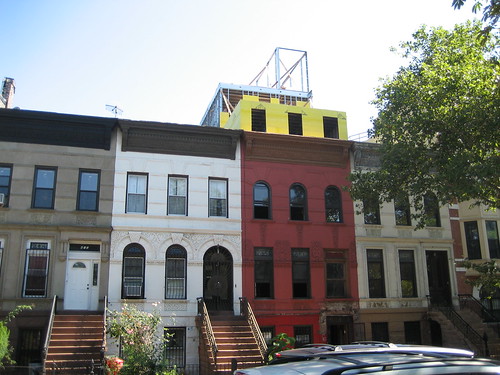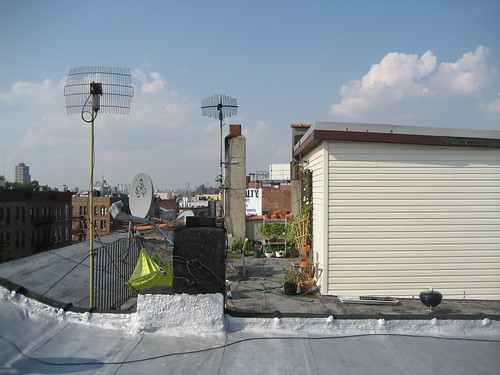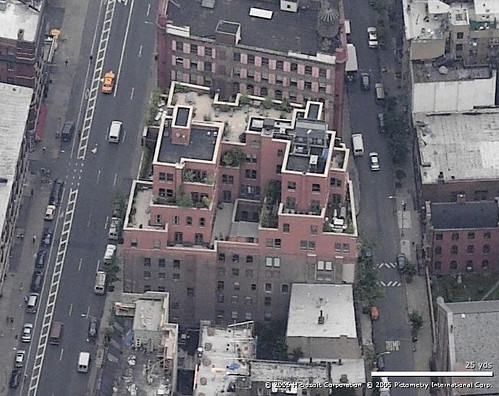unused FAR
One of my favorite development phenomena is the construction of a new building on top of an old one.

The primary metric used to govern building size in the New York City Zoning Resolution is Floor Area Ratio (FAR). Rather than being measured by their height or volume, buildings are measured by their FAR, which is equal to the total floor area of a building divided by the lot area. Thus a three story building that covers half its lot will have an FAR of 1.5.
 Three Buildings with 1.0 FAR
Three Buildings with 1.0 FAR
One strategy developers use to make money is to look for buildings below the maximum allowable FAR in an area where there is high demand for housing. Then they buy the buildings with a low FAR, tear them down, and build a bigger building (with the maximum allowable FAR) in their place. This is a lucrative business in many neighborhoods. (And not just in NYC.)
The problem is that by tearing down the buildings, developers can change the character of the neighborhood, eliminating the feel of the place which made the area popular in the first place. New York's Department of City Planning (DCP) has made several efforts to combat this problem. The introduction of transferable air rights, for example, allows developers to transfer floor area from smaller buildings to other nearby sites. This discourages the demolition of existing buildings, but it has the side effect, for better or for worse, of creating things like the Lower East Side's new Blue development.

Rendering from Curbed.com. THOR is The Hotel On Rivington. I'll get a photo of the work-in-progress soon.
That's why it's so great when instead of tearing a building down, a developer chooses to simply add to a building's FAR by building on top. Sometimes, this addition can be very small. Imagine having a permanent tent on your roof that you lived in. I think it would be pretty sweet.

Sometimes these additions can be quite well designed and attractive. The best one I've seen in New York is just south of the Puck Building, at 285 Lafayette St. (The Broadway-Lafayette stop on the BDFV trains is just to the north of the photo below.)

The addition was made with the redder brick. This image is from http://local.live.com/, the coolest thing Microsoft has ever made.
Throughout New York, there are many areas where this kind of construction is taking place. (Take a look at Dumbo next time you're taking a train over the Manhattan Bridge.) Still, I think the city could do more to encourage this kind of development. Besides preserving the character of a streetscape, it also has relatively low capital costs, which means that many more people can become 'developers.' A few thoughtful zoning amendments could make thousands of existing buildings threatened by demolition into the foundations for new houses.
Something to think about, anyway.

The primary metric used to govern building size in the New York City Zoning Resolution is Floor Area Ratio (FAR). Rather than being measured by their height or volume, buildings are measured by their FAR, which is equal to the total floor area of a building divided by the lot area. Thus a three story building that covers half its lot will have an FAR of 1.5.
 Three Buildings with 1.0 FAR
Three Buildings with 1.0 FAROne strategy developers use to make money is to look for buildings below the maximum allowable FAR in an area where there is high demand for housing. Then they buy the buildings with a low FAR, tear them down, and build a bigger building (with the maximum allowable FAR) in their place. This is a lucrative business in many neighborhoods. (And not just in NYC.)
The problem is that by tearing down the buildings, developers can change the character of the neighborhood, eliminating the feel of the place which made the area popular in the first place. New York's Department of City Planning (DCP) has made several efforts to combat this problem. The introduction of transferable air rights, for example, allows developers to transfer floor area from smaller buildings to other nearby sites. This discourages the demolition of existing buildings, but it has the side effect, for better or for worse, of creating things like the Lower East Side's new Blue development.

Rendering from Curbed.com. THOR is The Hotel On Rivington. I'll get a photo of the work-in-progress soon.
That's why it's so great when instead of tearing a building down, a developer chooses to simply add to a building's FAR by building on top. Sometimes, this addition can be very small. Imagine having a permanent tent on your roof that you lived in. I think it would be pretty sweet.

Sometimes these additions can be quite well designed and attractive. The best one I've seen in New York is just south of the Puck Building, at 285 Lafayette St. (The Broadway-Lafayette stop on the BDFV trains is just to the north of the photo below.)

The addition was made with the redder brick. This image is from http://local.live.com/, the coolest thing Microsoft has ever made.
Throughout New York, there are many areas where this kind of construction is taking place. (Take a look at Dumbo next time you're taking a train over the Manhattan Bridge.) Still, I think the city could do more to encourage this kind of development. Besides preserving the character of a streetscape, it also has relatively low capital costs, which means that many more people can become 'developers.' A few thoughtful zoning amendments could make thousands of existing buildings threatened by demolition into the foundations for new houses.
Something to think about, anyway.

3 comments:
I think my favorite use is the Hearst Building
How much per squre foot does a roof FAR addition cost? Is there a limit on the ceiling height of a room addition you can put on your roof?
nicolo:
Good questions. I wish I had some better answers...
Question 1: Given the specificity of each build scenario, I imagine roof additions would vary dramatically in cost. I've been told before that a 4-story rowhouse has construction costs of about $150/sq ft. I would imagine that a rooftop addition would cost at least as much (and possibly a lot more.)
Question 2: The zoning code generally doesn't restrict ceiling height at all in residential districts. I'm not at all familiar with the NYC building code, however, which could possibly have that sort of regulation for an addition.
Thanks for commenting!
Post a Comment